Ihsen Alouani
Attention Eclipse: Manipulating Attention to Bypass LLM Safety-Alignment
Feb 21, 2025Abstract:Recent research has shown that carefully crafted jailbreak inputs can induce large language models to produce harmful outputs, despite safety measures such as alignment. It is important to anticipate the range of potential Jailbreak attacks to guide effective defenses and accurate assessment of model safety. In this paper, we present a new approach for generating highly effective Jailbreak attacks that manipulate the attention of the model to selectively strengthen or weaken attention among different parts of the prompt. By harnessing attention loss, we develop more effective jailbreak attacks, that are also transferrable. The attacks amplify the success rate of existing Jailbreak algorithms including GCG, AutoDAN, and ReNeLLM, while lowering their generation cost (for example, the amplified GCG attack achieves 91.2% ASR, vs. 67.9% for the original attack on Llama2-7B/AdvBench, using less than a third of the generation time).
Are Neuromorphic Architectures Inherently Privacy-preserving? An Exploratory Study
Nov 10, 2024
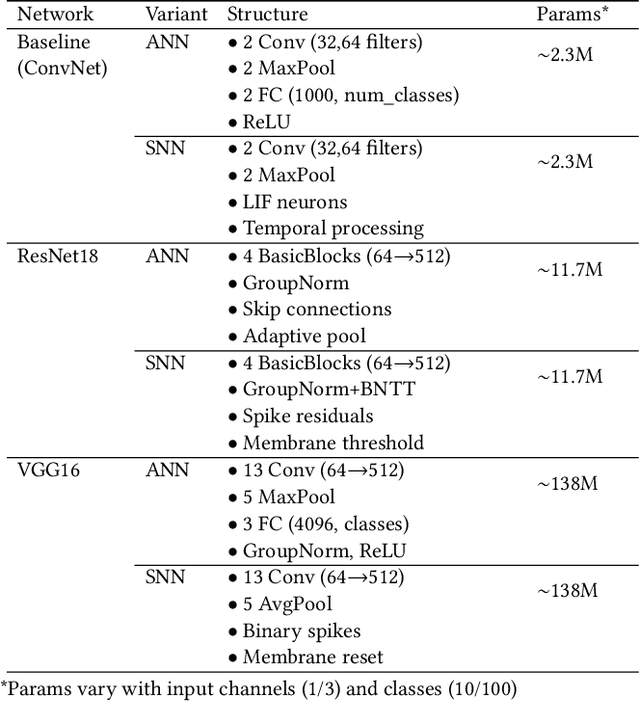
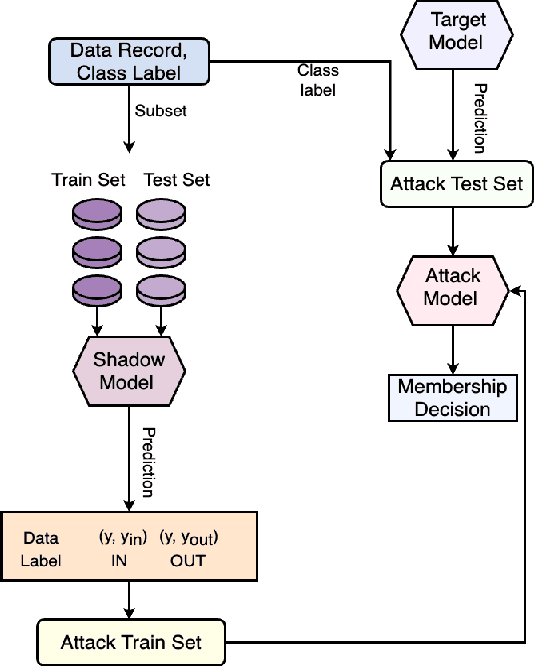
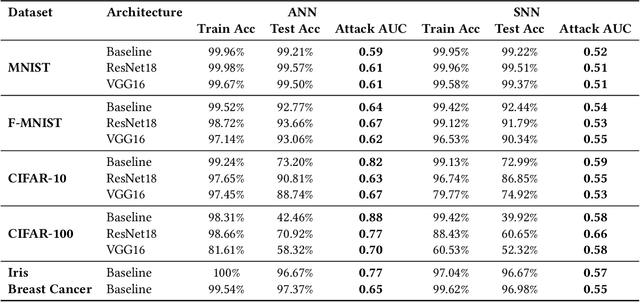
Abstract:While machine learning (ML) models are becoming mainstream, especially in sensitive application areas, the risk of data leakage has become a growing concern. Attacks like membership inference (MIA) have shown that trained models can reveal sensitive data, jeopardizing confidentiality. While traditional Artificial Neural Networks (ANNs) dominate ML applications, neuromorphic architectures, specifically Spiking Neural Networks (SNNs), are emerging as promising alternatives due to their low power consumption and event-driven processing, akin to biological neurons. Privacy in ANNs is well-studied; however, little work has explored the privacy-preserving properties of SNNs. This paper examines whether SNNs inherently offer better privacy. Using MIAs, we assess the privacy resilience of SNNs versus ANNs across diverse datasets. We analyze the impact of learning algorithms (surrogate gradient and evolutionary), frameworks (snnTorch, TENNLab, LAVA), and parameters on SNN privacy. Our findings show that SNNs consistently outperform ANNs in privacy preservation, with evolutionary algorithms offering additional resilience. For instance, on CIFAR-10, SNNs achieve an AUC of 0.59, significantly lower than ANNs' 0.82, and on CIFAR-100, SNNs maintain an AUC of 0.58 compared to ANNs' 0.88. Additionally, we explore the privacy-utility trade-off with Differentially Private Stochastic Gradient Descent (DPSGD), finding that SNNs sustain less accuracy loss than ANNs under similar privacy constraints.
Model for Peanuts: Hijacking ML Models without Training Access is Possible
Jun 03, 2024



Abstract:The massive deployment of Machine Learning (ML) models has been accompanied by the emergence of several attacks that threaten their trustworthiness and raise ethical and societal concerns such as invasion of privacy, discrimination risks, and lack of accountability. Model hijacking is one of these attacks, where the adversary aims to hijack a victim model to execute a different task than its original one. Model hijacking can cause accountability and security risks since a hijacked model owner can be framed for having their model offering illegal or unethical services. Prior state-of-the-art works consider model hijacking as a training time attack, whereby an adversary requires access to the ML model training to execute their attack. In this paper, we consider a stronger threat model where the attacker has no access to the training phase of the victim model. Our intuition is that ML models, typically over-parameterized, might (unintentionally) learn more than the intended task for they are trained. We propose a simple approach for model hijacking at inference time named SnatchML to classify unknown input samples using distance measures in the latent space of the victim model to previously known samples associated with the hijacking task classes. SnatchML empirically shows that benign pre-trained models can execute tasks that are semantically related to the initial task. Surprisingly, this can be true even for hijacking tasks unrelated to the original task. We also explore different methods to mitigate this risk. We first propose a novel approach we call meta-unlearning, designed to help the model unlearn a potentially malicious task while training on the original task dataset. We also provide insights on over-parameterization as one possible inherent factor that makes model hijacking easier, and we accordingly propose a compression-based countermeasure against this attack.
Watermarking Neuromorphic Brains: Intellectual Property Protection in Spiking Neural Networks
May 07, 2024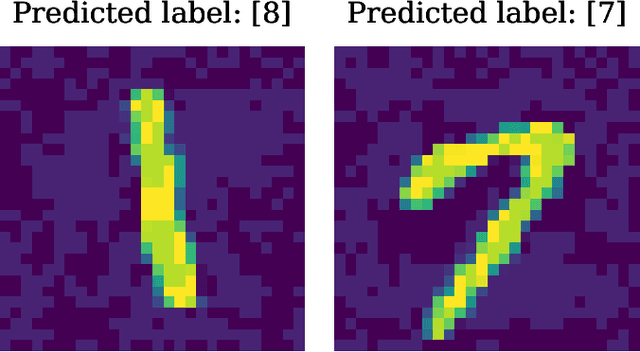
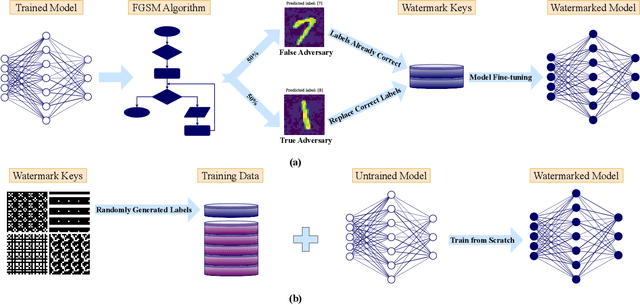
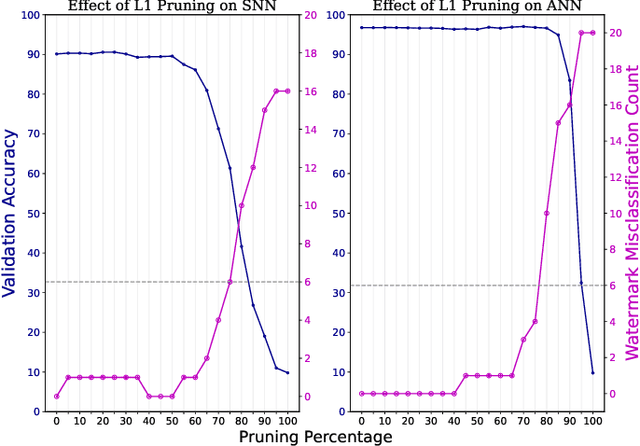
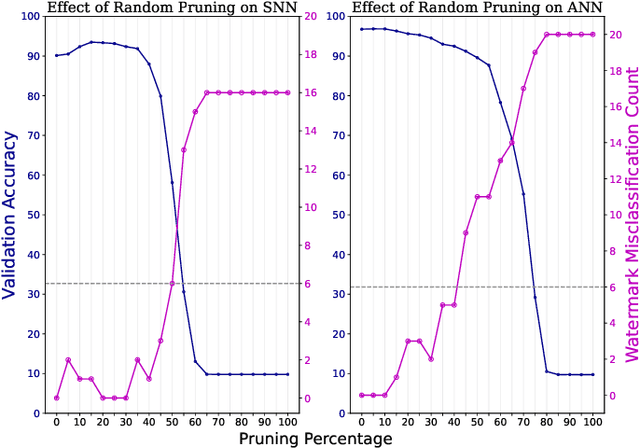
Abstract:As spiking neural networks (SNNs) gain traction in deploying neuromorphic computing solutions, protecting their intellectual property (IP) has become crucial. Without adequate safeguards, proprietary SNN architectures are at risk of theft, replication, or misuse, which could lead to significant financial losses for the owners. While IP protection techniques have been extensively explored for artificial neural networks (ANNs), their applicability and effectiveness for the unique characteristics of SNNs remain largely unexplored. In this work, we pioneer an investigation into adapting two prominent watermarking approaches, namely, fingerprint-based and backdoor-based mechanisms to secure proprietary SNN architectures. We conduct thorough experiments to evaluate the impact on fidelity, resilience against overwrite threats, and resistance to compression attacks when applying these watermarking techniques to SNNs, drawing comparisons with their ANN counterparts. This study lays the groundwork for developing neuromorphic-aware IP protection strategies tailored to the distinctive dynamics of SNNs.
SSAP: A Shape-Sensitive Adversarial Patch for Comprehensive Disruption of Monocular Depth Estimation in Autonomous Navigation Applications
Mar 18, 2024



Abstract:Monocular depth estimation (MDE) has advanced significantly, primarily through the integration of convolutional neural networks (CNNs) and more recently, Transformers. However, concerns about their susceptibility to adversarial attacks have emerged, especially in safety-critical domains like autonomous driving and robotic navigation. Existing approaches for assessing CNN-based depth prediction methods have fallen short in inducing comprehensive disruptions to the vision system, often limited to specific local areas. In this paper, we introduce SSAP (Shape-Sensitive Adversarial Patch), a novel approach designed to comprehensively disrupt monocular depth estimation (MDE) in autonomous navigation applications. Our patch is crafted to selectively undermine MDE in two distinct ways: by distorting estimated distances or by creating the illusion of an object disappearing from the system's perspective. Notably, our patch is shape-sensitive, meaning it considers the specific shape and scale of the target object, thereby extending its influence beyond immediate proximity. Furthermore, our patch is trained to effectively address different scales and distances from the camera. Experimental results demonstrate that our approach induces a mean depth estimation error surpassing 0.5, impacting up to 99% of the targeted region for CNN-based MDE models. Additionally, we investigate the vulnerability of Transformer-based MDE models to patch-based attacks, revealing that SSAP yields a significant error of 0.59 and exerts substantial influence over 99% of the target region on these models.
BrainLeaks: On the Privacy-Preserving Properties of Neuromorphic Architectures against Model Inversion Attacks
Feb 01, 2024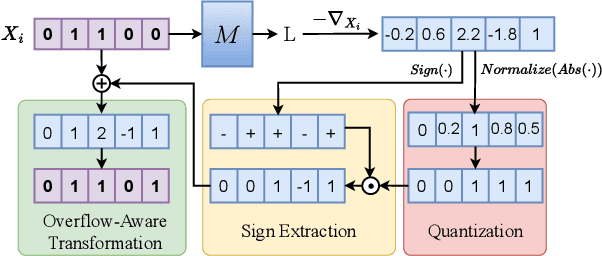

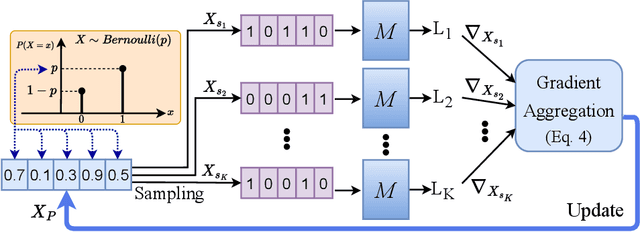

Abstract:With the mainstream integration of machine learning into security-sensitive domains such as healthcare and finance, concerns about data privacy have intensified. Conventional artificial neural networks (ANNs) have been found vulnerable to several attacks that can leak sensitive data. Particularly, model inversion (MI) attacks enable the reconstruction of data samples that have been used to train the model. Neuromorphic architectures have emerged as a paradigm shift in neural computing, enabling asynchronous and energy-efficient computation. However, little to no existing work has investigated the privacy of neuromorphic architectures against model inversion. Our study is motivated by the intuition that the non-differentiable aspect of spiking neural networks (SNNs) might result in inherent privacy-preserving properties, especially against gradient-based attacks. To investigate this hypothesis, we propose a thorough exploration of SNNs' privacy-preserving capabilities. Specifically, we develop novel inversion attack strategies that are comprehensively designed to target SNNs, offering a comparative analysis with their conventional ANN counterparts. Our experiments, conducted on diverse event-based and static datasets, demonstrate the effectiveness of the proposed attack strategies and therefore questions the assumption of inherent privacy-preserving in neuromorphic architectures.
Evasive Hardware Trojan through Adversarial Power Trace
Jan 04, 2024Abstract:The globalization of the Integrated Circuit (IC) supply chain, driven by time-to-market and cost considerations, has made ICs vulnerable to hardware Trojans (HTs). Against this threat, a promising approach is to use Machine Learning (ML)-based side-channel analysis, which has the advantage of being a non-intrusive method, along with efficiently detecting HTs under golden chip-free settings. In this paper, we question the trustworthiness of ML-based HT detection via side-channel analysis. We introduce a HT obfuscation (HTO) approach to allow HTs to bypass this detection method. Rather than theoretically misleading the model by simulated adversarial traces, a key aspect of our approach is the design and implementation of adversarial noise as part of the circuitry, alongside the HT. We detail HTO methodologies for ASICs and FPGAs, and evaluate our approach using TrustHub benchmark. Interestingly, we found that HTO can be implemented with only a single transistor for ASIC designs to generate adversarial power traces that can fool the defense with 100% efficiency. We also efficiently implemented our approach on a Spartan 6 Xilinx FPGA using 2 different variants: (i) DSP slices-based, and (ii) ring-oscillator-based design. Additionally, we assess the efficiency of countermeasures like spectral domain analysis, and we show that an adaptive attacker can still design evasive HTOs by constraining the design with a spectral noise budget. In addition, while adversarial training (AT) offers higher protection against evasive HTs, AT models suffer from a considerable utility loss, potentially rendering them unsuitable for such security application. We believe this research represents a significant step in understanding and exploiting ML vulnerabilities in a hardware security context, and we make all resources and designs openly available online: https://dev.d18uu4lqwhbmka.amplifyapp.com
May the Noise be with you: Adversarial Training without Adversarial Examples
Dec 12, 2023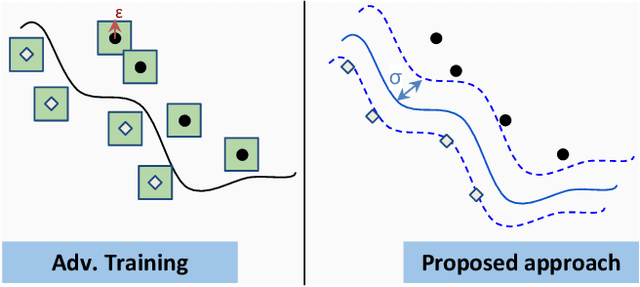
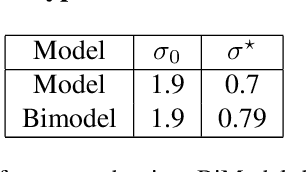
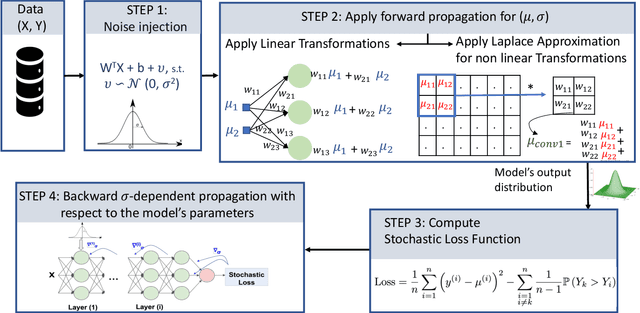

Abstract:In this paper, we investigate the following question: Can we obtain adversarially-trained models without training on adversarial examples? Our intuition is that training a model with inherent stochasticity, i.e., optimizing the parameters by minimizing a stochastic loss function, yields a robust expectation function that is non-stochastic. In contrast to related methods that introduce noise at the input level, our proposed approach incorporates inherent stochasticity by embedding Gaussian noise within the layers of the NN model at training time. We model the propagation of noise through the layers, introducing a closed-form stochastic loss function that encapsulates a noise variance parameter. Additionally, we contribute a formalized noise-aware gradient, enabling the optimization of model parameters while accounting for stochasticity. Our experimental results confirm that the expectation model of a stochastic architecture trained on benign distribution is adversarially robust. Interestingly, we find that the impact of the applied Gaussian noise's standard deviation on both robustness and baseline accuracy closely mirrors the impact of the noise magnitude employed in adversarial training. Our work contributes adversarially trained networks using a completely different approach, with empirically similar robustness to adversarial training.
Fool the Hydra: Adversarial Attacks against Multi-view Object Detection Systems
Nov 30, 2023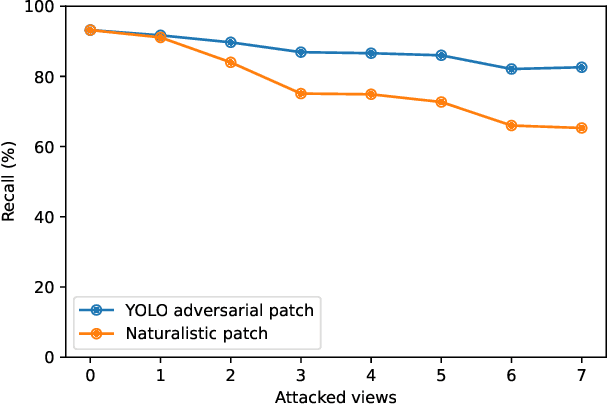
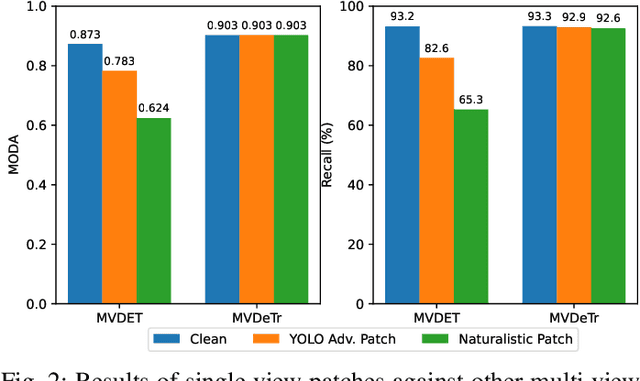
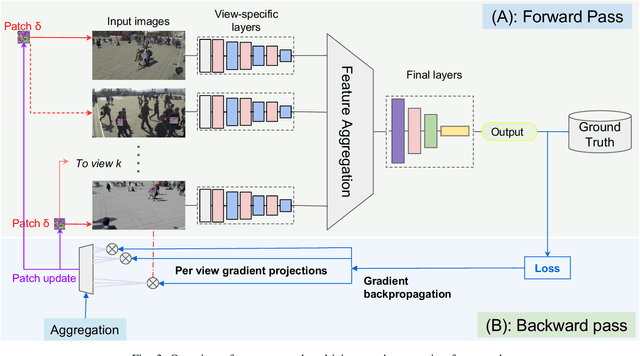
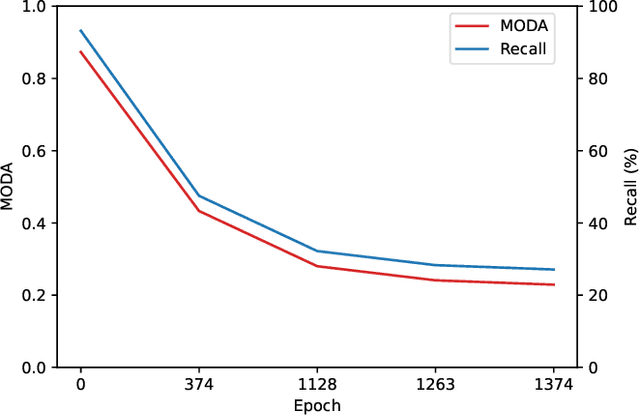
Abstract:Adversarial patches exemplify the tangible manifestation of the threat posed by adversarial attacks on Machine Learning (ML) models in real-world scenarios. Robustness against these attacks is of the utmost importance when designing computer vision applications, especially for safety-critical domains such as CCTV systems. In most practical situations, monitoring open spaces requires multi-view systems to overcome acquisition challenges such as occlusion handling. Multiview object systems are able to combine data from multiple views, and reach reliable detection results even in difficult environments. Despite its importance in real-world vision applications, the vulnerability of multiview systems to adversarial patches is not sufficiently investigated. In this paper, we raise the following question: Does the increased performance and information sharing across views offer as a by-product robustness to adversarial patches? We first conduct a preliminary analysis showing promising robustness against off-the-shelf adversarial patches, even in an extreme setting where we consider patches applied to all views by all persons in Wildtrack benchmark. However, we challenged this observation by proposing two new attacks: (i) In the first attack, targeting a multiview CNN, we maximize the global loss by proposing gradient projection to the different views and aggregating the obtained local gradients. (ii) In the second attack, we focus on a Transformer-based multiview framework. In addition to the focal loss, we also maximize the transformer-specific loss by dissipating its attention blocks. Our results show a large degradation in the detection performance of victim multiview systems with our first patch attack reaching an attack success rate of 73% , while our second proposed attack reduced the performance of its target detector by 62%
Attention Deficit is Ordered! Fooling Deformable Vision Transformers with Collaborative Adversarial Patches
Nov 21, 2023Abstract:The latest generation of transformer-based vision models have proven to be superior to Convolutional Neural Network (CNN)-based models across several vision tasks, largely attributed to their remarkable prowess in relation modeling. Deformable vision transformers significantly reduce the quadratic complexity of modeling attention by using sparse attention structures, enabling them to be used in larger scale applications such as multi-view vision systems. Recent work demonstrated adversarial attacks against transformers; we show that these attacks do not transfer to deformable transformers due to their sparse attention structure. Specifically, attention in deformable transformers is modeled using pointers to the most relevant other tokens. In this work, we contribute for the first time adversarial attacks that manipulate the attention of deformable transformers, distracting them to focus on irrelevant parts of the image. We also develop new collaborative attacks where a source patch manipulates attention to point to a target patch that adversarially attacks the system. In our experiments, we find that only 1% patched area of the input field can lead to 0% AP. We also show that the attacks provide substantial versatility to support different attacker scenarios because of their ability to redirect attention under the attacker control.
 Add to Chrome
Add to Chrome Add to Firefox
Add to Firefox Add to Edge
Add to Edge